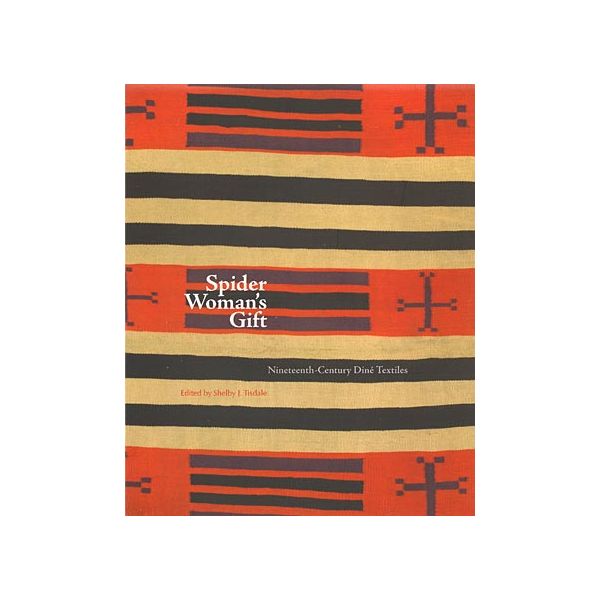SPIDER WOMAN'S GIFT BY TISDALE
$24.95
SKU
31125901
Spider Woman's Gift: Nineteenth-Century Dine Textiles, edited by Shelby J. Tisdale
"Between the red canyon walls of Canyon de Chelly in Arizona, in the heart of the Navajo Nation, stands an eight-hundred-foot sandstone rock formation known as Spider Rock. According to Dine oral history, this sacred place is where Spider Woman, or Na ashe'ii'tasdzaa, makes her home. For centuries, her gift of weaving has provided the Dine with a constant means of sustenance.
Dine textile and basketry weavings in Santa Fe's Museum of Indian Arts and Culture collections created between the 1850s and the 1890s allow us to explore the oral history of Spider Woman and the early history of the Dine during this time. The emphasis here is on how oral history impacts Native American cultures in general and in particular how Spider Woman influences Dine material culture.
Presented are two viewpoints on Dine weaving. One is the perspective of Dine weaver and museum educator, Joyce Begay-Foss; other, that of anthropologist, Marian Rodee, a well-known Dine textile scholar.
Starting with early baskets, we find visual evidence of Spider Woman's influence, for it was this early knowledge of hand weaving and dyes that transferred into early textile weaving after the Dine acquired wool.
The Dine textiles dating from 1840 to 188o were primarily made for Native use, as well as for intertribal trade. They include one-piece dresses, mantas, two-piece dresses, women's shoulder blankets, and ponchos. Designs range from simple bands and stripes to intricate interlocking serape patterns. Of particular interest are fine examples of highly recognised chief blankets, as well as the crowning achievement of classic-period serapes showing the finest de-signs and materials."
softcover, 95 pages
"Between the red canyon walls of Canyon de Chelly in Arizona, in the heart of the Navajo Nation, stands an eight-hundred-foot sandstone rock formation known as Spider Rock. According to Dine oral history, this sacred place is where Spider Woman, or Na ashe'ii'tasdzaa, makes her home. For centuries, her gift of weaving has provided the Dine with a constant means of sustenance.
Dine textile and basketry weavings in Santa Fe's Museum of Indian Arts and Culture collections created between the 1850s and the 1890s allow us to explore the oral history of Spider Woman and the early history of the Dine during this time. The emphasis here is on how oral history impacts Native American cultures in general and in particular how Spider Woman influences Dine material culture.
Presented are two viewpoints on Dine weaving. One is the perspective of Dine weaver and museum educator, Joyce Begay-Foss; other, that of anthropologist, Marian Rodee, a well-known Dine textile scholar.
Starting with early baskets, we find visual evidence of Spider Woman's influence, for it was this early knowledge of hand weaving and dyes that transferred into early textile weaving after the Dine acquired wool.
The Dine textiles dating from 1840 to 188o were primarily made for Native use, as well as for intertribal trade. They include one-piece dresses, mantas, two-piece dresses, women's shoulder blankets, and ponchos. Designs range from simple bands and stripes to intricate interlocking serape patterns. Of particular interest are fine examples of highly recognised chief blankets, as well as the crowning achievement of classic-period serapes showing the finest de-signs and materials."
softcover, 95 pages



